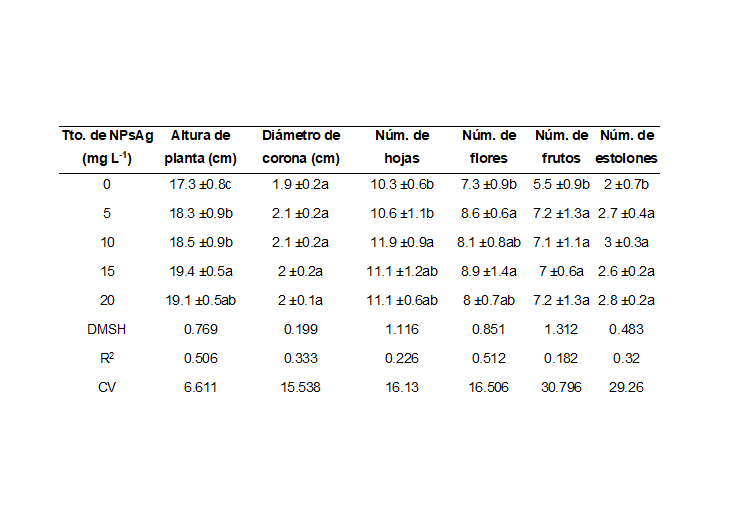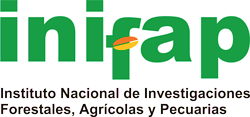Application of silver nanoparticles and their relationship with the growth of strawberry
DOI:
https://doi.org/10.29312/remexca.v16i5.3738Keywords:
Fragaria x ananassa Duch., berries, development, nanotechnologyAbstract
The use of silver nanoparticles has increased recently due to their application in different areas of science. In plants, they have shown different effects depending on the species and concentration. The present research aimed to evaluate the effect of applying silver nanoparticles via the leaves and roots at increasing doses on the growth of plants of strawberry (Fragaria x ananassa Duch.) cultivar Festival. The experiment was established in a greenhouse in the experimental agricultural field of the UACH, Texcoco, State of Mexico, in 2022 and 2023. Strawberry plants of the Festival cultivar were used as plant material and placed in an open hydroponic system. Subsequently, silver nanoparticles were applied via the leaves (0, 40, 80, 120 and 160 mg L-1) and roots (0, 5, 10, 15 and 20 mg L-1), respectively. At 56 days after the start of treatments, plant height, crown diameter, number of leaves, number of runners, number of flowers and number of fruits were recorded, showing as results that foliar dosing of silver nanoparticles increased crown diameter (25.8%), number of leaves (19.8%), number of flowers (18.3%), number of fruits (28.3%) and number of runners (50%), and root dosing increased plant height (11.9%), number of leaves (14.9%), number of flowers (21.1%), number of fruits (31.8%), and number of runners (31.8%). In conclusion, the application of silver nanoparticles via the leaves and roots increases the growth variables measured in strawberry plants of the Festival cultivar; therefore, silver nanoparticles are an alternative for food sovereignty.
Downloads
References
Abbas, H. K. and Abdulhussein, M. A. 2021. Improving shoot multiplication of strawberry (Fragaria ananassa L. Cv. Roby Gem) in vitro by using agnps and iron nanoparticles. Nveo-Natural Volatiles & Essential Oils. 7(14):2521-2530.
Adisa, I. O.; Pullagurala, V. L. R.; Peralta-Videa, J. R.; Dimkpa, C. O.; Elmer, W. H.; Gardea-Torresdey, J. L. and White, J. C. 2019. Recent advances in nano-enabled fertilizers and pesticides: a critical review of mechanisms of action. Environmental Science: Nano. 6(7):2002-2030. https://doi.org/10.1039/C9EN00265K.
Alkaç, O. S.; Öcalan, O. N. and Güneş, M. 2022. Effect of silver nanoparticles treatments on some characteristics of “santander” Lily cultivar. Turkish Journal of Agriculture Food Science and Technology. 10(2):125-128. https://doi.org/10.24925/turjaf.v10i2.125-128.4386.
Byczyńska, A.; Zawadzińska, A. and Salachna, P. 2019. Silver nanoparticles preplant bulb soaking affects tulip production. Acta Agriculturae Scandinavica, Section B - Soil & Plant Science. 69(3):250-256. https://doi.org/10.1080/09064710.2018.1545863.
Casillas-Figueroa, F.; Arellano-García, M. E.; Leyva-Aguilera, C.; Ruíz-Ruíz, B.; Luna Vázquez-Gómez, R.; Radilla-Chávez, P.; Chávez-Santoscoy, R. A.; Pestryakov, A.; Toledano-Magaña, Y.; García-Ramos, J. C. and Bogdanchikova, N. 2020. Argovit™ silver nanoparticles effects on Allium cepa: plant growth promotion without cyto genotoxic damage. Nanomaterials. 10(7):1386-1406. https://doi.org/10.3390/nano10071386.
Das, P.; Barua, S.; Sarkar, S.; Karak, N.; Bhattacharyya, P.; Raza, N.; Bhattacharyya, P.; Raza, N.; Kim, K. H. and Bhattacharya, S. S. 2018. Plant extract mediated green silver nanoparticles: efficacy as soil conditioner and plant growth promoter. Journal of Hazardous Materials. 201862(346):62-72. https://doi:10.1016/j.jhazmat.2017.12.020.
El-Batal, A. I.; Gharib, F. A. E. L.; Ghazi, S. M.; Hegazi, A. Z. and Hafz, A. G. M. A. E. 2016. Physiological responses of two varieties of common bean (Phaseolus vulgaris L.) to foliar application of silver nanoparticles. nanomaterials and nanotechnology. 6(13):1-16. https://doi.org/10.5772/62202.
Gupta, S. D.; Agarwal, A. and Pradhan, S. 2018. Phytostimulatory effect of silver nanoparticles (AgNPs) on rice seedling growth: an insight from antioxidative enzyme activities and gene expression patterns. Ecotoxicology and Environmental Safety. 2018624(161):624-633. Doi:10.1016/j.ecoenv.2018.06.023.
Juárez-Moreno, K.; González, E. B.; Girón-Vázquez, N.; Chávez-Santoscoy, R.; Mota-Morales, J. and Perez-Mozqueda, L. 2016. Comparison of cytotoxicity and genotoxicity effects of silver nanoparticles on human cervix and breast cancer cell lines. Human & Amp. Experimental Toxicology. 36(9):931-948. https://doi.org/10.1177/0960327116675206.
Rezvani, N.; Sorooshzadeh, A. and Farhadi, N. 2012. Effect of nano-silver on growth of saffron in flooding stress. International Journal of Agricultural and Biosystems Engineering. 6(1):11-16.
Sadak, M. S. 2019. Impact of silver nanoparticles on plant growth, some biochemical aspects, and yield of fenugreek plant (Trigonella foenum-graecum). Bulletin of the National Research Centre. 43(1):1-6. https://doi.org/10.1186/s42269-019-0077-y.
Safa, Z.; Hashemabadi, D.; Kaviani, B.; Nikchi, N. and Zarchini, M. 2015. Studies on quality and vase life of cut Gerbera jamesonii cv. ‘Balance’ flowers by silver nanoparticles and chlorophenol. Journal of Environmental Biology. 36(2):425-431.
Salachna, P.; Byczyńska, A.; Zawadzińska, A.; Piechocki, R. and Mizielińska, M. 2019. Stimulatory effect of silver nanoparticles on the growth and flowering of potted oriental lilies. Agronomy. 9(10):610-624. https://doi.org/10.3390/agronomy9100610.
Sarmast, M. K. and Salehi, H. 2021. Sub-lethal concentrations of silver nanoparticles mediate a phytostimulatory response in tobacco via the suppression of ethylene biosynthetic genes and the ethylene-signaling pathway. In Vitro Cellular & Developmental Biology-Plant. 58(2022):1-14. https://doi.org/10.1007/s11627-021-10193-1.
Shams, G.; Ranjbar, M. and Amiri, A. 2013. Effect of silver nanoparticles on concentration of silver heavy element and growth indexes in cucumber (Cucumis sativus cv. negeen). Journal of Nanoparticle Research. 1630(15):1-12. https://doi.org/10.1007/s11051-013-1630-5.
SIAP. 2024. Servicio de Información Agroalimentaria y Pesquera. Avance de siembras y cosechas resumen nacional. https://nube.siap.gob.mx/avance-agricola/.
Singh, R. P.; Handa, R. and Manchanda, G. 2020. Nanoparticles in sustainable agriculture: an emerging opportunity. Journal of Controlled Release. 329(2021):1234-1248. https://doi.org/10.1016/j.jconrel.2020.10.051.
Steiner A. A. 1984. The universal nutrient solution. Proceeding 6th International Congress on soilless culture. ISOSC. Lunteren, Netherlands. 633-650 pp.
Tung, H. T.; Thuong, T. T.; Cuong, D. M.; Luan, V. Q.; Hien, V. T.; Hieu, T.; Nam, B. M.; Phuong, H. T. N.; Vinh, V. B. T.; Khai, H. D. and Nhut, D. T. 2021. Silver nanoparticles improved explant disinfection, in vitro growth, runner formation and limited ethylene accumulation during micropropagation of strawberry (Fragaria x ananassa Duch.). Plant Cell, Tissue and Organ Culture (PCTOC). 145(2):393-403. https://doi.org/10.1007/s11240-021-02015-4.
Ur Rahim, H.; Qaswar, M.; Uddin, M.; Giannini, C.; Herrera, M. L. and Rea, G. 2021. Nano-enable materials promoting sustainability and resilience in modern agriculture. Nanomaterials. 11(8):2068-2095. https://doi.org/10.3390/nano11082068.
Vinković, T.; Novák, O.; Strnad, M.; Goessler, W.; Jurašin, D. D.; Parađiković, N. and Vrček, I. V. 2017. Cytokinin response in pepper plants (Capsicum annuum L.) exposed to silver nanoparticles. Environmental Research. 201710(156):10-18. https://doi.org/10.1016/j.envres.2017.03.015.
Yan, A. and Chen, Z. 2019. Impacts of silver nanoparticles on plants: a focus on the phytotoxicity and underlying mechanism. International Journal of Molecular Sciences. 20(5):1003-1024. https://doi.org/10.3390/ijms20051003.
Younes, N. A. and Nassef, D. M. T. 2016. Effect of silver nanoparticles on salt tolerancy of tomato trans-plants (Solanum lycopersicom Mill.). Assiut Journal of Agricultural Sciences. 46(6):76-85. https://doi.org/10.21608/ajas.2016.522.
Zhang, W.; Ke, S.; Sun, C.; Xu, X.; Chen, J. and Yao, L. 2019. Fate and toxicity of silver nanoparticles in freshwater from laboratory to realistic environments: a review. Environmental Science and Pollution Research. 8(26):7390-7404. https://doi.org/10.1007/s11356-019-04150-0.

Published
How to Cite
Issue
Section
License
Copyright (c) 2025 Revista Mexicana de Ciencias Agrícolas

This work is licensed under a Creative Commons Attribution-NonCommercial 4.0 International License.
The authors who publish in Revista Mexicana de Ciencias Agrícolas accept the following conditions:
In accordance with copyright laws, Revista Mexicana de Ciencias Agrícolas recognizes and respects the authors’ moral right and ownership of property rights which will be transferred to the journal for dissemination in open access. Invariably, all the authors have to sign a letter of transfer of property rights and of originality of the article to Instituto Nacional de Investigaciones Forestales, Agrícolas y Pecuarias (INIFAP) [National Institute of Forestry, Agricultural and Livestock Research]. The author(s) must pay a fee for the reception of articles before proceeding to editorial review.
All the texts published by Revista Mexicana de Ciencias Agrícolas —with no exception— are distributed under a Creative Commons License Attribution-NonCommercial 4.0 International (CC BY-NC 4.0), which allows third parties to use the publication as long as the work’s authorship and its first publication in this journal are mentioned.
The author(s) can enter into independent and additional contractual agreements for the nonexclusive distribution of the version of the article published in Revista Mexicana de Ciencias Agrícolas (for example include it into an institutional repository or publish it in a book) as long as it is clearly and explicitly indicated that the work was published for the first time in Revista Mexicana de Ciencias Agrícolas.
For all the above, the authors shall send the Letter-transfer of Property Rights for the first publication duly filled in and signed by the author(s). This form must be sent as a PDF file to: revista_atm@yahoo.com.mx; cienciasagricola@inifap.gob.mx; remexca2017@gmail.
This work is licensed under a Creative Commons Attribution-Noncommercial 4.0 International license.


